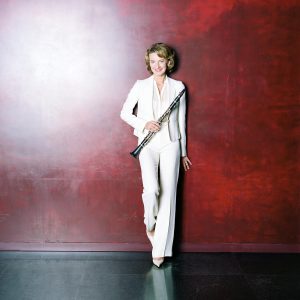Alliage Quintet
Perth Concert Hall
reviewed by Neville Cohn
 It was an evening of pure delight with six players, each at the very top of their game, delivering the sort of musical magic critics long for but so rarely encounter in reality. For Perth audiences, the stand-out name would have been Sabine Meyer, grand mistress of the clarinet who, once heard, is never forgotten.
It was an evening of pure delight with six players, each at the very top of their game, delivering the sort of musical magic critics long for but so rarely encounter in reality. For Perth audiences, the stand-out name would have been Sabine Meyer, grand mistress of the clarinet who, once heard, is never forgotten.
In many decades as a music critic, Monday was the first occasion I’d had to listen to a saxophone quartet – and was it worth the wait? Unquestionably. These four gentlemen who in interpretative, sonic and pitch terms, cannot be faulted – and who play as if drawing from a shared source of inspiration – would almost certainly have won over those who might have come to the concert in doubt about whether such an ensemble should have appeared on a Musica Viva program.
This concert was the last in a gruelling tour of Australian cities yet they played – and threw in a witty comment here and there – as if they’d come to town after a restful holiday. There was about almost everything on offer a delightful joie de vivre.
And within the democracy of so rarely encountered an ensemble, these players demonstrated the form that has justly earned the highest praise, in a performance that would surely have raised the spirits of even the most dour of concertgoers.
Every item on the program was an arrangement of a well-known work, much-loved pieces by, inter alia, Borodin, Bernstein, Dukas, and Stravinsky.
Some of the most meaningful playing of the evening focussed on extracts from the latter’s The Firebird, with players pooling their wondrous capabilities in a way that gave fresh meaning to some of the finest music to come out of the 20th century. Familiar notes in very different guise made for frankly thrilling listening. Indeed, whether sinister, tranquil or wild, Stravinsky’s ideas were heard to wonderful advantage.
How, I wondered, would Stravinsky have responded to his music performed in a chamber music version. I’d like to think he’d have loved it.
Sabine Meyer, grand mistress of the clarinet, was at her authoritative best on Monday, bringing point and meaning to everything she played with an awesomely fine ability to shape a faultless phrase. Allied to this were a faultless sense of style and evocation of mood. I cannot too highly praise such artistry.
Milhaud’s Scaramouche is known to millions, most frequently in a version for two pianos. But an arrangement for 4 saxophones by Sebastian Pottmeier (who is baritone saxophonist of the Alliage Quintet), came across as an essay in gleeful insouciance.
I wonder what Borodin would have thought of his Polovtsian Dances presented by Meyer and the Alliage Quintet. I rather think he’d have been chuffed no end. I savoured another old favourite in new guise:
A lavish bouquet to Jang Eun Bae who, for much of the evening, provided piano accompaniments which were the last word in musical subtlety.



